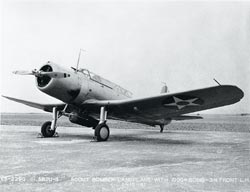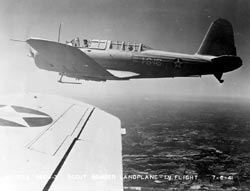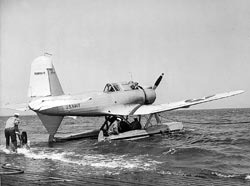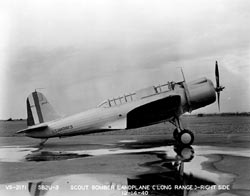|
 The SB2U-3 was an upgraded SB2U-2 designed to meet a U. S. Marine Corps requirement for a dive-bomber with a longer range than the BG-1’s then in service. To meet this requirement for a long-range capability, Vought offered the Marine Corps a new variant of the SB2U with increased fuel capacity. On September 25, 1939, the proposal was accepted and Vought received a contract for 57 aircraft under the designation SB2U3. The SB2U-3 was an upgraded SB2U-2 designed to meet a U. S. Marine Corps requirement for a dive-bomber with a longer range than the BG-1’s then in service. To meet this requirement for a long-range capability, Vought offered the Marine Corps a new variant of the SB2U with increased fuel capacity. On September 25, 1939, the proposal was accepted and Vought received a contract for 57 aircraft under the designation SB2U3.
The XSB2U-3 prototype started out as a standard production SB2U-1 and was converted to the proposed SB2U-3 configuration. The changes included: an increase in the span of the horizontal stabilizers from 13 feet 4 inches to 15 feet 2 1/16 inches, a substantially increased internal fuel supply, provisions for four forward-firing .50-caliber machine guns, and a .50caliber machine gun for the observer.  The engine was changed from the 825-horsepower Pratt & Whitney R-1535-96 to the 825-horsepower Pratt & Whitney R-1535-02. These changes resulted in an increase of some 921 pounds in the aircraft’s empty weight. The improvements made to the basic airplane did little or nothing to improve its performance; therefore the increased weight of fuel caused the SB2U-3’s performance to suffer. The engine was changed from the 825-horsepower Pratt & Whitney R-1535-96 to the 825-horsepower Pratt & Whitney R-1535-02. These changes resulted in an increase of some 921 pounds in the aircraft’s empty weight. The improvements made to the basic airplane did little or nothing to improve its performance; therefore the increased weight of fuel caused the SB2U-3’s performance to suffer.
 The increased fuel capacity was achieved by increasing the main fuel tank capacity and adding three additional tanks to the wing center section. These tanks were unprotected and would later prove to be a major problem in combat. The increased tankage plus a 50-gallon external auxiliary centerline tank gave the SB2U-3 a range of 2,640 miles (or a search radius of 1,320 miles) for a search and scout mission. When armed with a 1,000-pound bomb load the SB2U-3 had a combat radius of 560 miles for a dive bomb mission. The increased fuel capacity was achieved by increasing the main fuel tank capacity and adding three additional tanks to the wing center section. These tanks were unprotected and would later prove to be a major problem in combat. The increased tankage plus a 50-gallon external auxiliary centerline tank gave the SB2U-3 a range of 2,640 miles (or a search radius of 1,320 miles) for a search and scout mission. When armed with a 1,000-pound bomb load the SB2U-3 had a combat radius of 560 miles for a dive bomb mission.
 The XSB2U-3 was flown for the first time during February 1939. After a brief period of testing, the aircraft was returned to the Vought factory where it was fitted with a pair of Edo floats. It was returned to NAS Anacostia, Washington, D.C. to resume testing during April. Difficulties in water handling led to the aircraft being modified with a large ventral fin and larger water rudders on the floats. As a result, the Navy decided that there was only limited value in a float scout aircraft and the production contract for the SB2U-3 specified that all 57 aircraft be produced as landplanes with retractable landing gear. It is a little known fact that the first production SB2U-3 was actually delivered as a float aircraft then reconfigured as a land plane before formal acceptance by the Marines. The XSB2U-3 was flown for the first time during February 1939. After a brief period of testing, the aircraft was returned to the Vought factory where it was fitted with a pair of Edo floats. It was returned to NAS Anacostia, Washington, D.C. to resume testing during April. Difficulties in water handling led to the aircraft being modified with a large ventral fin and larger water rudders on the floats. As a result, the Navy decided that there was only limited value in a float scout aircraft and the production contract for the SB2U-3 specified that all 57 aircraft be produced as landplanes with retractable landing gear. It is a little known fact that the first production SB2U-3 was actually delivered as a float aircraft then reconfigured as a land plane before formal acceptance by the Marines.
It was during the production run of the SB2U-3 that the Navy decided to give the aircraft a name and bestowed the name “Vindicator” to the entire SB2U series. Deliveries of SB2U-3’s began on March 14, 1941 when VMS-2, based at NAS North Island, San Diego, California, received their first aircraft (BuNo 2045). A total of 27 SB2U-3’s were delivered to VMS-2 between March 14 and April 30, 1940. VMS-2 was followed by VMS-1 at MCAS Quantico, Virginia, on May 9. Like its sister squadron, VMS-1 received a total of 27 aircraft with the last being delivered during July of 1941.
Marine SB2U-3’s stationed at Midway took part in the Battle of Midway. On the second day, Capt. Richard E. Fleming, after being hit by the Zero’s protecting the Japanese fleet, dived his burning plane at the Japanese cruiser Mogami. For his actions, he was posthumously awarded the Congressional Medal of Honor, the first Marine pilot to receive this award.
SB2U:
Atlantic Operations
Combat at Midway
Phase Out
|